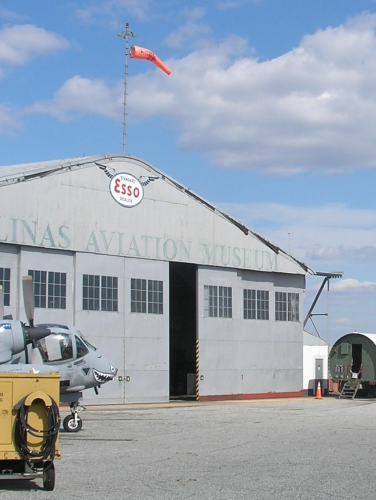
W.P.A. Douglas Airport Hanger
(ca. 1937)
Now part of the Sullenburger Aviation Museum, the W.P.A. Douglas Airport Hangar is a final reminder of the federally funded Depression era program that created Charlotte Douglas Airport.
4108 Minuteman Way, Charlotte, NC 28208
Erected by the Works Progress Administration, the W.P.A. Douglas Airport Hangar was tied to a federal work program that preserved Charlotteans’ skills and self-respect during the Great Depression. Of the original structures built by the W.P.A. at the airport, only the hangar remains. Used until 1985, the hanger was abandoned and fell into disrepair until, in the early 1990s, it became part of the Carolinas Aviation Museum, now known as the Sullenburger Aviation Museum.
Property Quick Links
In an era when commercial flight was relatively new, Charlotte Mayor Ben Elbert Douglas (1894-1981) pushed for a major municipal airport to provide adequate passenger and airmail service for the greater Charlotte region. In 1935, with the backing of the Charlotte Chamber of Commerce, Mayor Douglas led the Charlotte City Council in authorizing an application for W.P.A. funding to build an airport. The application was quickly approved, and construction began in December 1935.
Created by President Franklin D. Roosevelt during the massive national unemployment and economic devastation created by the Depression, the W.P.A. developed work programs for the construction of thousands of public buildings and facilities. By the end of 1939, 125,000 unemployed North Carolinians had sought gainful employment from nearly 4,000 in-state W.P.A. projects. At the time, Charlotte’s airport was the W.P.A.’s largest North Carolina project in terms of allotted funds. By June 1937, the new Charlotte Municipal Airport included an administration/terminal building, one hangar, a beacon tower, and three runways. The U.S. Department of Commerce added a radio-beam system and control building the following year to facilitate blind flying and landing. Of those structures, only the hangar remains. The airport was named “Douglas Municipal” in 1940 in honor of the city’s forward-thinking mayor and offered six daily flights within its first year of operation.
The federal government significantly expanded the airport during World War II: lengthening and widening the runways, building over ninety new structures (including a hangar-repair facility, hospital, reservoir, shops, and barracks), and constructing the adjacent Charlotte Air Base military installation (later Morris Field). Meanwhile, the W.P.A. hangar serviced and stored planes for civilian flights in and out of Charlotte, allowing for continued commercial flights during the war effort. In 1946, after investing more than five million dollars in the site, the War Assets Corporation conveyed the property back to the City of Charlotte. As the city’s post-war economy grew, so too did its airport, with the construction of a new airport terminal, hangars, and repair facilities to serve the region’s burgeoning transportation needs. The more modern facilities eventually relegated the W.P.A. Hanger to second-class status, although it remained in use for fixed base operations and small chartered private planes until 1985.

